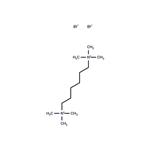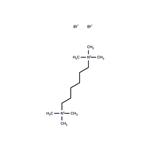Description
Hexamethonium is a peripherally-acting nondepolarizing neuromuscular blocking agent that acts as an antagonist of nicotinic acetylcholine receptors (nAChRs). It decreases acetylcholine release induced by carbamoylcholine in isolated cat superior cervical ganglion when used at concentrations of 27.4 and 54.8 μg/ml. It also decreases mean arterial pressure in unanesthetized rats when administered at a dose of 40 mg/kg. Intraventricular administration of hexamethonium (18 ng, i.c.v.) induces signs of nicotine abstinence, including shaking, writhing, and chewing in nicotine-dependent rats. Formulations containing hexamethonium were previously used in the treatment of hypertension.
Manufacturing Process
Hexamethylene diamine (116 g), sodium carbonate (466 g), and water (800
ml) were heated to 60°C, and dimethyl sulfate (830 g) added with stirring
over 1% hours keeping the temperature below 90°C. The reaction mixture
was then stirred at 90°C for 2 hours, then cooled to 20°C, acetone (1,200 ml)
added and the whole cooled to 0°C.
The solid formed was removed by filtration and washed with acetone (150
ml). Filtrate and washings were diluted with water to 4 liters and heated to
60°C under reflux. To this was added a solution prepared from embonic acid
(388 g), sodium hydroxide (80 g) and water (5 liters), the whole refluxed for
10 minutes and thereafter allowed to cool overnight.
The resultant embonate (530 g) was filtered off, washed twice with a solution
of acetone (75 ml) in water (425 ml), and dried at 100°C to give an
amorphous yellow powder, MP 290°C to 291°C (with decomp.). 588 g of the
embonate was dissolved in boiling water (4 liters).
Hydrobromic acid 50% w/w (325 g) diluted with water (2 liters) was added
slowly at the boil and the precipitated embonic acid removed by filtering hot
and washing twice with hot water (1 liter). The filtrate and washings were
evaporated to dryness in a steam pan and the residue recrystallized from
ethyl alcohol (1,200 ml), to yield the dibromide (320 g).




